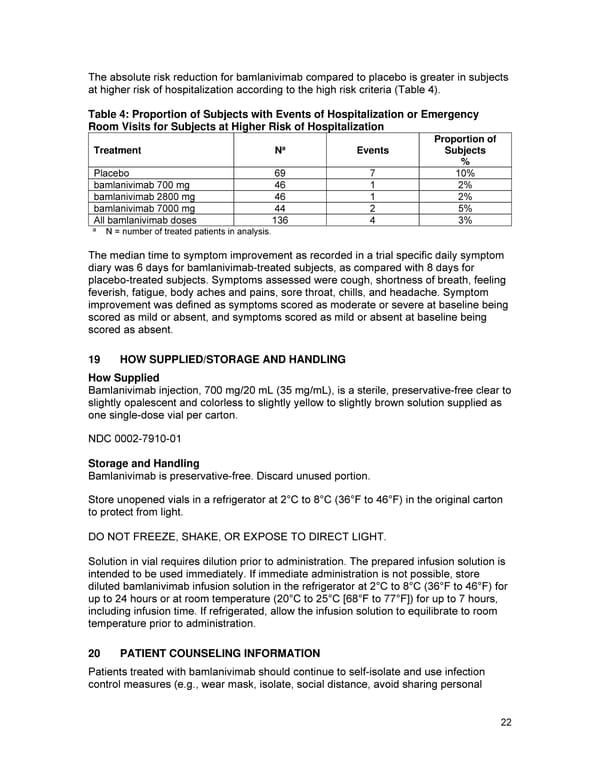The absolute risk reduction for bamlanivimab compared to placebo is greater in subjects at higher risk of hospitalization according to the high risk criteria (Table 4). Table 4: Proportion of Subjects with Events of Hospitalization or Emergency Room Visits for Subjects at Higher Risk of Hospitalization Proportion of a Treatment N Events Subjects % Placebo 69 7 10% bamlanivimab 700 mg 46 1 2% bamlanivimab 2800 mg 46 1 2% bamlanivimab 7000 mg 44 2 5% All bamlanivimab doses 136 4 3% a N = number of treated patients in analysis. The median time to symptom improvement as recorded in a trial specific daily symptom diary was 6 days for bamlanivimab-treated subjects, as compared with 8 days for placebo-treated subjects. Symptoms assessed were cough, shortness of breath, feeling feverish, fatigue, body aches and pains, sore throat, chills, and headache. Symptom improvement was defined as symptoms scored as moderate or severe at baseline being scored as mild or absent, and symptoms scored as mild or absent at baseline being scored as absent. 19 HOW SUPPLIED/STORAGE AND HANDLING How Supplied Bamlanivimab injection, 700 mg/20 mL (35 mg/mL), is a sterile, preservative-free clear to slightly opalescent and colorless to slightly yellow to slightly brown solution supplied as one single-dose vial per carton. NDC 0002-7910-01 Storage and Handling Bamlanivimab is preservative-free. Discard unused portion. Store unopened vials in a refrigerator at 2°C to 8°C (36°F to 46°F) in the original carton to protect from light. DO NOT FREEZE, SHAKE, OR EXPOSE TO DIRECT LIGHT. Solution in vial requires dilution prior to administration. The prepared infusion solution is intended to be used immediately. If immediate administration is not possible, store diluted bamlanivimab infusion solution in the refrigerator at 2°C to 8°C (36°F to 46°F) for up to 24 hours or at room temperature (20°C to 25°C [68°F to 77°F]) for up to 7 hours, including infusion time. If refrigerated, allow the infusion solution to equilibrate to room temperature prior to administration. 20 PATIENT COUNSELING INFORMATION Patients treated with bamlanivimab should continue to self-isolate and use infection control measures (e.g., wear mask, isolate, social distance, avoid sharing personal 22
 Fact Sheet for Health Care Providers Page 21 Page 23
Fact Sheet for Health Care Providers Page 21 Page 23